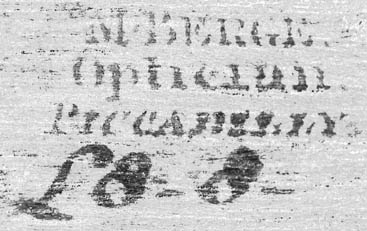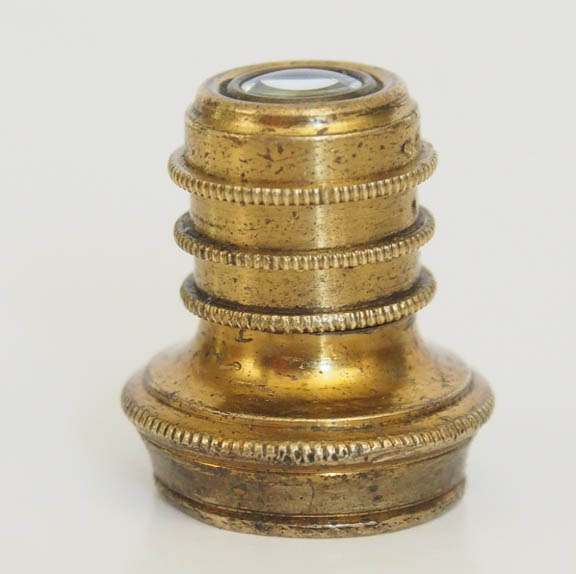By Dr. Jurriaan de Groot*:
DESCRIPTION: This brass microscope resembles an instrument attributed to Gilbert & Co (see Golub No 147) in construction and the original model may have featured folding tripod legs. Similarly, it has a rectangular section fixed support- and sliding focus pillars, whereby the latter has a rack recessed into it and is moved by a pinion activated by a milled knob on the right- hand side. The support for the circular stage, which has lugs for a stage-mounted bullseye condenser (missing) and a stage forceps, is fixed and attached to the rear plate by a brass bolt which runs through the square shaped top of a round vertical brass pillar and is held in place by a round milled-edge nut. The pillar is 123 mm tall and screws into a brass boss affixed to a block of wood placed centrally within the case.
It is of interest that tension is maintained between the support and sliding pillars by means of 2 brass leaf springs located into each backplate with a small locating pin.
This provides for a smooth focus action and predates the sprung focus designs used by Hugh Powell by some 30 years. The horizontal arm is affixed to the sliding pillar at the top. There is a circular screw ring at the other end of the arm onto which a single low power lens with blackened eyecup can be screwed for use as a simple microscope. Alternatively, the brass compound tube which is 110 mm long and contains 2 biconvex eye lenses and a plano-convex field lens can be screwed into the arm. There is a single concave mirror on a sliding support affixed to the tail-end of the support pillar. The mahogany case measures 214 x 155 x 60 mm. When in use with the compound body, the microscope, which itself is unsigned, stands 305 mm tall.
 Shown to the left is a black & white enhanced image of the small stamp in black ink on the inside of the lid, which reads: 'M BERGE, Optician, PICCADILLY, £8_, 8_'. The price may have been added by pen and ink.
Shown to the left is a black & white enhanced image of the small stamp in black ink on the inside of the lid, which reads: 'M BERGE, Optician, PICCADILLY, £8_, 8_'. The price may have been added by pen and ink.
OBJECTIVES:
HISTORY PERTAINING TO THE BERGE CASE-MOUNTED MICROSCOPE:
Mathew Berge worked as foreman in the workshop of the well-known Instrument-maker Jesse Ramsden (1735-1800) and became his successor upon Ramsden’s death in 1800. Mathew Berge himself died in 1819 (see: Gloria Clifton – Directory of British Scientific Instrument Makers) and so it is likely that this microscope, which was probably made ‘for the trade,’ was retailed by him between 1800-1819 for the then considerable sum of 8 Guineas. Although there is a superficial resemblance to the later Cary-Gould design of portable microscope, it pre-dates this by a number of years and is an interesting example of a microscope from the late pre-achromatic period.
*As always, we are grateful to Dr Jurriaan de Groot for contributing the text and images here about one of his microscopes.
 Shown to the left is a black & white enhanced image of the small stamp in black ink on the inside of the lid, which reads: 'M BERGE, Optician, PICCADILLY, £8_, 8_'. The price may have been added by pen and ink.
Shown to the left is a black & white enhanced image of the small stamp in black ink on the inside of the lid, which reads: 'M BERGE, Optician, PICCADILLY, £8_, 8_'. The price may have been added by pen and ink.
